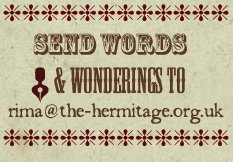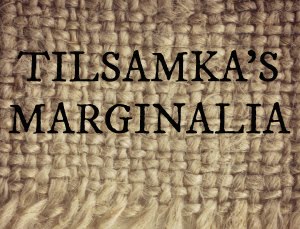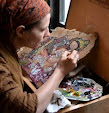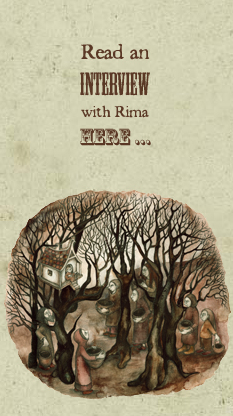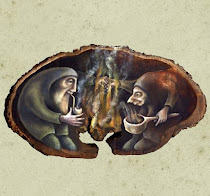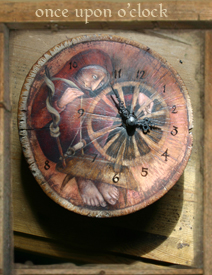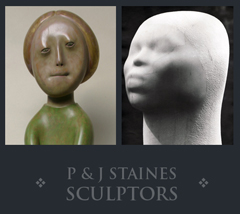IT IS BUSY here, a house of paintings and cistern-leakings, album finishings and off-to-town sellings, so in the meantime I thought I'd leave you with a favourite piece from a favourite Netherlandish painting... the beautifully painted and beautifully sad close up of Mary's weeping face in Rogier van der Weyden's Deposition.
A happy weekend to you all ...
Friday, 30 May 2008
Rogier van der Weyden
Written by
Rima Staines
at
6:20 pm
6
words from others
![]()
Tags: dutch school, netherlandish painting, rogier van der weyden
Friday, 23 May 2008
Witch Bottle

OVER THE LAST few days this Witch Bottle will have been crossing some of your house thresholds. So I thought it time to introduce her, and tell you why her crossing your threshold might have been quite a horrifying thought had you been living centuries ago. She is painted with oils on burr walnut wood and the idea is based on an old English folk magic, evidence of which has come to light in the rebuilding and renovating of old buildings in recent years. The practice of making witch bottles dates back at least to the 15th century and is a form of apotropaic charm (i.e. one that wards off evil). If someone believed that they were the victim of a witch's spell, they would take an old pot-bellied bottle, often made of blue or green glass, or a stoneware container known as a Bellarmine (named after the rather dreadful bearded face that decorated the side of these bottles, which reminded folk of Cardinal Robert Bellarmine who was a persecutor of protestants and labeled a demon), and fill it with various curious ingredients...
If someone believed that they were the victim of a witch's spell, they would take an old pot-bellied bottle, often made of blue or green glass, or a stoneware container known as a Bellarmine (named after the rather dreadful bearded face that decorated the side of these bottles, which reminded folk of Cardinal Robert Bellarmine who was a persecutor of protestants and labeled a demon), and fill it with various curious ingredients... First the worried spell victim would drop in some bent iron nails or pins, then some of their own hair, and lastly their urine. Sometimes other items like thorns or pieces of wood, nail clippings, stones, bones, ash, menstrual blood, oil or coins were added to this. Then the bottle would be corked and buried in a significant place. Many witch bottles have been discovered underneath the hearth stone, hidden in walls or at the threshold of the house.
First the worried spell victim would drop in some bent iron nails or pins, then some of their own hair, and lastly their urine. Sometimes other items like thorns or pieces of wood, nail clippings, stones, bones, ash, menstrual blood, oil or coins were added to this. Then the bottle would be corked and buried in a significant place. Many witch bottles have been discovered underneath the hearth stone, hidden in walls or at the threshold of the house. The idea behind this was that if a witch was sending her spirit to harm you, she would most likely try to enter your home through a doorway, chimney, or other entranceway. If there was a concoction made from your own bodily fluids in her way, she would turn her attentions on that, presuming it was you and get herself caught on the bent iron nails. It is thought that in the case of bellarmines, the frightening face on the side of the bottle would further ward off evil.
The idea behind this was that if a witch was sending her spirit to harm you, she would most likely try to enter your home through a doorway, chimney, or other entranceway. If there was a concoction made from your own bodily fluids in her way, she would turn her attentions on that, presuming it was you and get herself caught on the bent iron nails. It is thought that in the case of bellarmines, the frightening face on the side of the bottle would further ward off evil. So if there appeared in the nearby vicinity someone with a dreadful sudden affliction or who experienced terrible pain whilst urinating, then it was likely to be the witch!
So if there appeared in the nearby vicinity someone with a dreadful sudden affliction or who experienced terrible pain whilst urinating, then it was likely to be the witch! Archaeologists have found only four bottles still completely intact with evidence of urine and hair and all sorts of other delights within. In fact, these witch bottles were often thought to explode on the death of the witch, so perhaps these are cases where the charm did not work.
Archaeologists have found only four bottles still completely intact with evidence of urine and hair and all sorts of other delights within. In fact, these witch bottles were often thought to explode on the death of the witch, so perhaps these are cases where the charm did not work.
If you are interested in learning more about strange popular superstitions, dried cats, old shoes and other Things Hidden In Walls, there are some excellent articles here at Apotropaios, where you are invited to send details of any odd things found hidden in your walls and under doorsills.
My witch is currently hiding here under my etsy doorsill, waiting to tell you her tale.
Written by
Rima Staines
at
1:44 pm
19
words from others
![]()
Tags: apotropaic, bellarmine, charm, folk magic, painting, superstition, witch bottle
Friday, 16 May 2008
Mum & Dad


 I WOULD like to tell you a little tale of my beginnings ... because I was brought into this world 28 years ago by two wonderful artists, who have passed very valuable things onto me. Not only do I have their eyes for looking at things and their art in my blood, I have seen through them that it is necessary and possible to make one's own work and a living at it. I know that I am lucky indeed to have a rich childhood treasure chest in my head to draw upon: of being surrounded by sculpture and art, of interesting places, of Bedford van travels across Europe, of strange bedtime stories, and of being a little different from everyone else.
I WOULD like to tell you a little tale of my beginnings ... because I was brought into this world 28 years ago by two wonderful artists, who have passed very valuable things onto me. Not only do I have their eyes for looking at things and their art in my blood, I have seen through them that it is necessary and possible to make one's own work and a living at it. I know that I am lucky indeed to have a rich childhood treasure chest in my head to draw upon: of being surrounded by sculpture and art, of interesting places, of Bedford van travels across Europe, of strange bedtime stories, and of being a little different from everyone else.
 My parents continue to make their art in their home, and have recently dipped their toes into this strange 21st century web world ... with a website, etsy shop and blog where you'll see delights indeed. To celebrate this, I thought I would show you some of their wonderful works and give you an idea of the inspiring household in which I grew up... with these creations on every windowsill, stair and shelf.
My parents continue to make their art in their home, and have recently dipped their toes into this strange 21st century web world ... with a website, etsy shop and blog where you'll see delights indeed. To celebrate this, I thought I would show you some of their wonderful works and give you an idea of the inspiring household in which I grew up... with these creations on every windowsill, stair and shelf.
My parents met in the 1970s in the plaster room of City & Guilds of London Art School where my mum was studying sculpture and my dad teaching it...
 My mum grew up in the wilds of New Zealand and finds much of her inspiration in memories of those hills and the nature there... She trained as a nurse before travelling through many countries to finally arrive in the UK to study sculpture, a discipline that was long bubbling in her, even as a child scraping clay from the riverbed to make forms... an example of this on the right, a young horse laying on its side, which she made when she was only 9.
My mum grew up in the wilds of New Zealand and finds much of her inspiration in memories of those hills and the nature there... She trained as a nurse before travelling through many countries to finally arrive in the UK to study sculpture, a discipline that was long bubbling in her, even as a child scraping clay from the riverbed to make forms... an example of this on the right, a young horse laying on its side, which she made when she was only 9.
 My dad was born in South London 10 years before the second world war, and on being asked what he would like to do when he grew up, would answer: "either a fighter pilot, a priest or an artist!" This last choice seems to have endured all his life, with a particular focus on his love for woodcarving. He has made a great variety of works in stone, wood and clay over the years, making figures for churches, architectural stone carvings, lettering, and a great body of his own work, in varying styles.
My dad was born in South London 10 years before the second world war, and on being asked what he would like to do when he grew up, would answer: "either a fighter pilot, a priest or an artist!" This last choice seems to have endured all his life, with a particular focus on his love for woodcarving. He has made a great variety of works in stone, wood and clay over the years, making figures for churches, architectural stone carvings, lettering, and a great body of his own work, in varying styles.
 I remember vividly the curls of wood on the floor of the workshop when I was small, and the smell of resin, and learned at a young age about the progression of a piece of art from its beginnings as a piece of wood, through many stages, agonies and hoorays to the final work.
I remember vividly the curls of wood on the floor of the workshop when I was small, and the smell of resin, and learned at a young age about the progression of a piece of art from its beginnings as a piece of wood, through many stages, agonies and hoorays to the final work.
From my mum amongst many many other things, I have inherited a sense of colour, design and form, and a fascination with people. 
 My dad has passed on to me, amongst many many other things, a love of the medieval, words, wooden things and wonkiness.
My dad has passed on to me, amongst many many other things, a love of the medieval, words, wooden things and wonkiness.
And I know that I am privileged to have such masters of the field as critics and encouragers... and I would like to thank them for always inspiring me, for this art in my blood and for truly knowing me. I hope that I can create works as beautiful as these one day.
Please welcome them and spread the word of their masterpieces...
The images on the left are my dad's work and on the right, my mum's.
Written by
Rima Staines
at
12:53 pm
18
words from others
![]()
Tags: childhood, inspiration, james staines, pamela staines, parents, rima staines, sculpture, wood carving
Monday, 12 May 2008
The Game
I THOUGHT I'd show you an interesting little something which I made a few years ago as the final piece on my Book Arts & Crafts degree... This piece is an ancient opening casket board game with an accompanying book which tells a story. The story, which I have written in rhyme, is set in a ‘Dark Age’ land not unlike England, and describes a man’s journey around his land in search of its people’s lost happiness and to overturn the evil king. Meanwhile two children dig up an old game and begin to play it. The journey takes a year and a day and as the main character travels, he passes through the four quarters (seasons, directions, elements, and times of day) which echo the four corners of the game and meets important characters on the way. Each move in the children’s game is mirrored in real life and a desperate battle between the rich few and the downtrodden masses builds momentum. The characters’ names are all Anglo-Saxon words which all have particular significance to the story. A glossary is included at the end of the book.
This piece is an ancient opening casket board game with an accompanying book which tells a story. The story, which I have written in rhyme, is set in a ‘Dark Age’ land not unlike England, and describes a man’s journey around his land in search of its people’s lost happiness and to overturn the evil king. Meanwhile two children dig up an old game and begin to play it. The journey takes a year and a day and as the main character travels, he passes through the four quarters (seasons, directions, elements, and times of day) which echo the four corners of the game and meets important characters on the way. Each move in the children’s game is mirrored in real life and a desperate battle between the rich few and the downtrodden masses builds momentum. The characters’ names are all Anglo-Saxon words which all have particular significance to the story. A glossary is included at the end of the book.
The story encompasses many themes –
~ The struggles of ordinary people under the rule of the dishonest rich and powerful, and a dream for equality, justice and a voice for us all; ~ My love for the earth and anger at its destruction;
~ My love for the earth and anger at its destruction;
~ A search to find value once again in life’s simple truths;
~ An exploration of ancient Pagan beliefs and Dark Age ideas about the world;
~ Ideas about balance and the wheel of life – accepting both life and death, day and night in all things;
~ A longing for a time before cars, concrete and all things industrial and corporate;
~ A desire to reawaken a love for stories and recognition of their importance in society.
The Game The rules of this board game are based on an Anglo-Saxon game, ‘Hnefatafl’ popular in this country between about AD 400 and AD 1000 when chess arrived. It was carried here from Scandinavia by the Norsemen who were continuing an ancient tradition amongst the northern European tribes. A more detailed history is contained within the accompanying book. This game is appropriate to the time in which the story is set, and the opposing forces are of unequal size and have different objectives. This ties in with the political theme to the book.
The rules of this board game are based on an Anglo-Saxon game, ‘Hnefatafl’ popular in this country between about AD 400 and AD 1000 when chess arrived. It was carried here from Scandinavia by the Norsemen who were continuing an ancient tradition amongst the northern European tribes. A more detailed history is contained within the accompanying book. This game is appropriate to the time in which the story is set, and the opposing forces are of unequal size and have different objectives. This ties in with the political theme to the book. Board games in ancient societies played a significant role over and above that of mere entertainment. The grid or chequerboard pattern has been described as a form of cosmological divination, representing the land, the universe, or the human body. The central square, as in Hnefatafl, signifies the city or the navel (indeed the word ‘hnefi’ - the king-piece - is also thought to be cognate with the word navel). Often this central point in a country was marked out by a sacred tree as in Glastonbury or Carmarthen, or a stone as at Tara. This place is one of central convergence, often the setting for fairs and obviously in the case of cities it is the seat of the ruler. The rules of Hnefatafl require that for the king’s side to win, the king must reach the edge of the board, signifying his complete dominion over the land. The opposing larger force must capture the king.
Board games in ancient societies played a significant role over and above that of mere entertainment. The grid or chequerboard pattern has been described as a form of cosmological divination, representing the land, the universe, or the human body. The central square, as in Hnefatafl, signifies the city or the navel (indeed the word ‘hnefi’ - the king-piece - is also thought to be cognate with the word navel). Often this central point in a country was marked out by a sacred tree as in Glastonbury or Carmarthen, or a stone as at Tara. This place is one of central convergence, often the setting for fairs and obviously in the case of cities it is the seat of the ruler. The rules of Hnefatafl require that for the king’s side to win, the king must reach the edge of the board, signifying his complete dominion over the land. The opposing larger force must capture the king.
The Illustrations The illustrations are based loosely on a gospel page illumination from the Book of Durrow (St Matthew's Gospel Folio 21v). This manuscript was produced around the 7th century at the monastery of Durrow, County Offaly which was founded by St Columba. Saint Matthew is depicted with a chequerboard body, echoing the idea of the board game/body, and the decorations are examples of Celtic and Pictish design.
The illustrations are based loosely on a gospel page illumination from the Book of Durrow (St Matthew's Gospel Folio 21v). This manuscript was produced around the 7th century at the monastery of Durrow, County Offaly which was founded by St Columba. Saint Matthew is depicted with a chequerboard body, echoing the idea of the board game/body, and the decorations are examples of Celtic and Pictish design.
The Font
The font design is based on alphabets in Anglo-Saxon manuscripts and other illuminated gospel books like the Books of Durrow and Kells.
The Board The board is made from spruce wood, stained and antiqued, making it look as if it has just been dug up. It is decorated to echo the illustrations from the book and each side corresponds with the four directions, seasons, elements and times of day. Each gift given to the main character by those he meets on the way is illustrated on the four sides. The board also displays symbols from the Ogham – an ancient magical script – the Celtic equivalent to the Runes. Each Ogham letter relates to a particular tree and time of year and is correspondingly displayed around the board.
The board is made from spruce wood, stained and antiqued, making it look as if it has just been dug up. It is decorated to echo the illustrations from the book and each side corresponds with the four directions, seasons, elements and times of day. Each gift given to the main character by those he meets on the way is illustrated on the four sides. The board also displays symbols from the Ogham – an ancient magical script – the Celtic equivalent to the Runes. Each Ogham letter relates to a particular tree and time of year and is correspondingly displayed around the board.
And here is an extract from the story:
As summer fullness smiled;
In contented, heady, pregnant air
Our Faran’s time was whiled.
Then around a corner one midday
Beside a meadow sweet
Came fiddle music, frisking-fast and
The sound of tapping feet.
Faran neared, intrigued to find
A flabbergasting sight ~
A motley stranger, red and yellow,
His costume chequered bright.
A wood contraption round his shoulders,
And hooked onto one end
A wobbling little whimsy-man,
A dancing puppet friend.
As the jester played the devil’s tune
And jigged all up and down,
It caused those puppet feet to tap
Of the wee lopsided clown.
By his side, a patchwork knapsack,
All bulging, tied with twine;
Some strange light from out the bag
Mysteriously did shine.
Faran tiptoed, quite bewildered
Closer to the gleeman;
‘How-di-do?’ The stranger asked him,
‘I s’pose you must be Faran?’
His face was funny, his eyes were fiery,
He’d a lilting, joking voice;
The puppet danced whene’er he moved
Because he had no choice.
‘My name’s Fyr’ grinned the jester,
‘I’ve come to join the dance;
Come sit awhile beside me here
And play my game of chance.’
The harlequin, ungainly-tall,
Sat his bright body down;
The wood contraption clacked and rattled;
The puppet seemed to frown.
So Faran sat and watched in awe
As the motley-magic-man
Reached inside his coloured sack;
And wild his blood it ran.
Out came dice and playing cards
And curiosities
And jumping beans and dominoes
And candles, tricks and keys.
And tiny phials all filled with fire
And stones and beads and sticks
And rare glass balls and wooden spoons,
A mad embroidered mix!
Chancy games and fateful tricks
The harlequin did play;
And all the while the puppet watched,
Not one word did he say.
Copyright © Rima Staines 2008

Written by
Rima Staines
at
3:13 pm
19
words from others
![]()
Tags: anglo saxon, board game, book, book of durrow, dark ages, hnefatafl, manuscript, norse legend, rhyme, rima staines
Thursday, 8 May 2008
Sunlight on windows and water
 THE SUNSHINE has been glorious these last few days and Tui and I have been out delighting in it. Down the lane a bit and round the corner is the place where our horsebox is parked, and there we've been spending our days toasting our noses and getting sawdust-sweaty working on our home on wheels. We've been up rickety ladders adding the first Very Exciting Thing to the lovely Bedford ~ a round window that hobbits would be proud of! It's a swiveling-opening delight which we put four quarters of glass into and now it lets lovely sunlight into the bedroom-quarters to be. And since there are no hobbits about, we're being very proud of it ourselves!
THE SUNSHINE has been glorious these last few days and Tui and I have been out delighting in it. Down the lane a bit and round the corner is the place where our horsebox is parked, and there we've been spending our days toasting our noses and getting sawdust-sweaty working on our home on wheels. We've been up rickety ladders adding the first Very Exciting Thing to the lovely Bedford ~ a round window that hobbits would be proud of! It's a swiveling-opening delight which we put four quarters of glass into and now it lets lovely sunlight into the bedroom-quarters to be. And since there are no hobbits about, we're being very proud of it ourselves!
And then after a cup of coffee on the tailgate I leave Tui to the sanding and climb down the steep hill to the stream below to sit and paint while the swallows swoop happily past almost skimming the surface of the water and an interested mother sheep and her two stripey-legged lambkins visit me closeby.
Yesterday I fell asleep in the heat of the afternoon and woke with my head in the oil paints!
So today I ventured down there with a pencil and sketchpad instead to draw imagined interiors for our home-to-be. And when I wasn't drawing, I sat by that cold Scottish splashing rushing stream in the hot May sun and read a frosty arctic tale of hot air balloons and bears in Philip Pullman's newest book Once Upon a Time in the North, featuring lovely little wood engravings by John Lawrence.
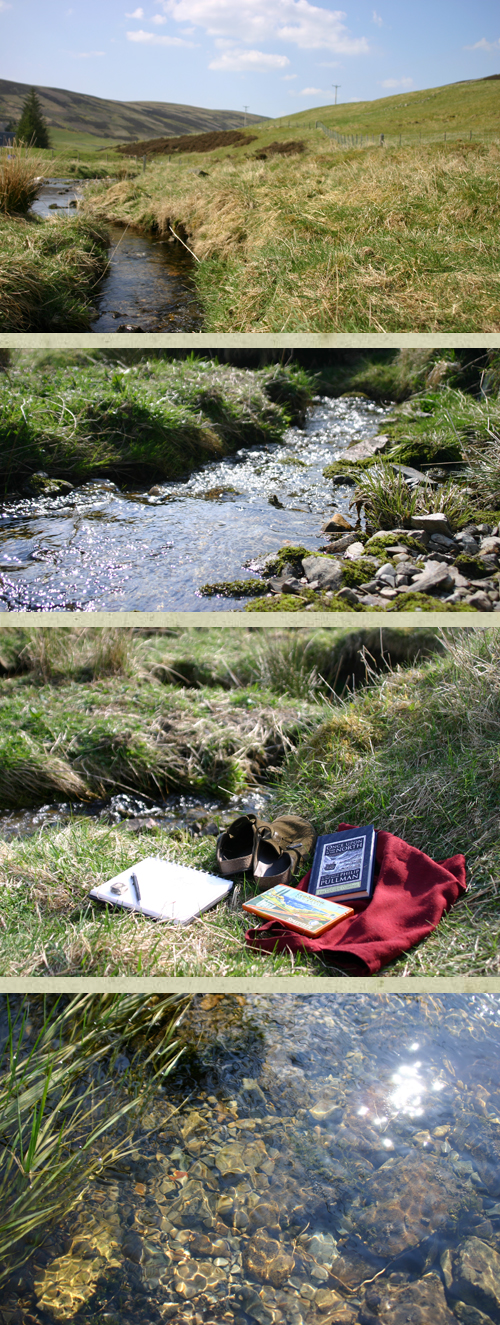
Written by
Rima Staines
at
7:13 pm
8
words from others
![]()
Tags: bedford tk, drawing, horsebox, once upon a time in the north, painting, philip pullman, round window, scotland, stream, summer
Monday, 5 May 2008
Manipura

 A YELLOW painting on a yellow day for you. The sun is shining beautiful warmly out there and here is the third in the series of seven paintings I am making for a client, finished a little while ago. There was going to be a stage by stage series of photographs for you of this painting progressing, with mistakes and changes and developings.. but alas they were on the hard drive. I am very pleased with this third character and his ram and with the yellowish scratchy paintwork, and so, I am happy to say, is his owner...
A YELLOW painting on a yellow day for you. The sun is shining beautiful warmly out there and here is the third in the series of seven paintings I am making for a client, finished a little while ago. There was going to be a stage by stage series of photographs for you of this painting progressing, with mistakes and changes and developings.. but alas they were on the hard drive. I am very pleased with this third character and his ram and with the yellowish scratchy paintwork, and so, I am happy to say, is his owner...
The painting series is to take place over some time so that even though there is a cohesive theme to the paintings, hopefully a development in my work will be evident in the seven pieces when they are all done.
I am finding it fascinating to read the thoughts of my client after he receives each painting. I find that the ideas I might subconsciously communicate in the works are not very easily accessible to me in a verbal way, which I suppose is why I paint. But to hear the thoughts and reactions of the "commissioner" written eloquently, is a luxury I am not used to, and encourages me that I must be doing something right. Number four will begin soon. A happy yellow monday to you all...
accessible to me in a verbal way, which I suppose is why I paint. But to hear the thoughts and reactions of the "commissioner" written eloquently, is a luxury I am not used to, and encourages me that I must be doing something right. Number four will begin soon. A happy yellow monday to you all...
Written by
Rima Staines
at
12:22 pm
10
words from others
![]()
Tags: chakra, manipura, oil painting, ram, yellow
Thursday, 1 May 2008
Wet socks and disappointment
 NEWS AT LAST, but it's bad news I'm sorry to say. On the day when folk like this cheerful bunch on the right might be flinging themselves eagerly around a garlanded maypole, I have far less fancy-free tidings.
NEWS AT LAST, but it's bad news I'm sorry to say. On the day when folk like this cheerful bunch on the right might be flinging themselves eagerly around a garlanded maypole, I have far less fancy-free tidings.
The hard drive people have sent me the final "diagnostic report" today following its £200 visit to a "sister company" to be fixed. Alas no data could be salvaged from it, and so that's apparently that. How very very disappointing this is. I am trying hard not to be suspicious about this company who may well have known that it was a dead end job at the beginning (they offer a no data, no fee service), so told me that it had to be sent to a "sister" company for a non returnable £200 to be fixed before they would know if the data was recoverable. I don't know. I would rather think the best of folk, so I am just going to have to swallow it and accept the loss. I am having it sent to my brother who has the right kind of brain and fiddly tools and who might just be able to do what the experts can't, but really I think that indeed is that.
I will be gathering any files lurking in the odd dusty corner of other people's machines, and unsold paintings can be rescanned. As for everything else... I will just begin again happily, and not dwell on what else might have been on that hard drive. Thank you again to everyone for their goodheartedness and words of hope. I've spent the rest of the kind donations on a new robust hard drive to replace the old one so that I can begin archiving my work again; it has a rugged orange off-road rubber protective jacket and an estimated maximum "drop height" of 35 inches!
Hey ho ... in other news... Telling the Bees now have a lovely new website, which I have been busy making this week, and the album is receiving jolly good words from folk all over the place.
We've had dreadful weather lately.. pelting hail storms and thunder and lightning. A visit to town the day before yesterday to get groceries and glass cut for our round window left me with squelching shoes and shivering soaking socks.
The mystery painting is to be completed this very evening and while the potatoes bake in the oven I invite you all to dry your wet socks by our lovely fire...
Written by
Rima Staines
at
5:40 pm
17
words from others
![]()
Tags: data recovery, disappointment, fireplace, hard drive, maypole, painting, telling the bees




